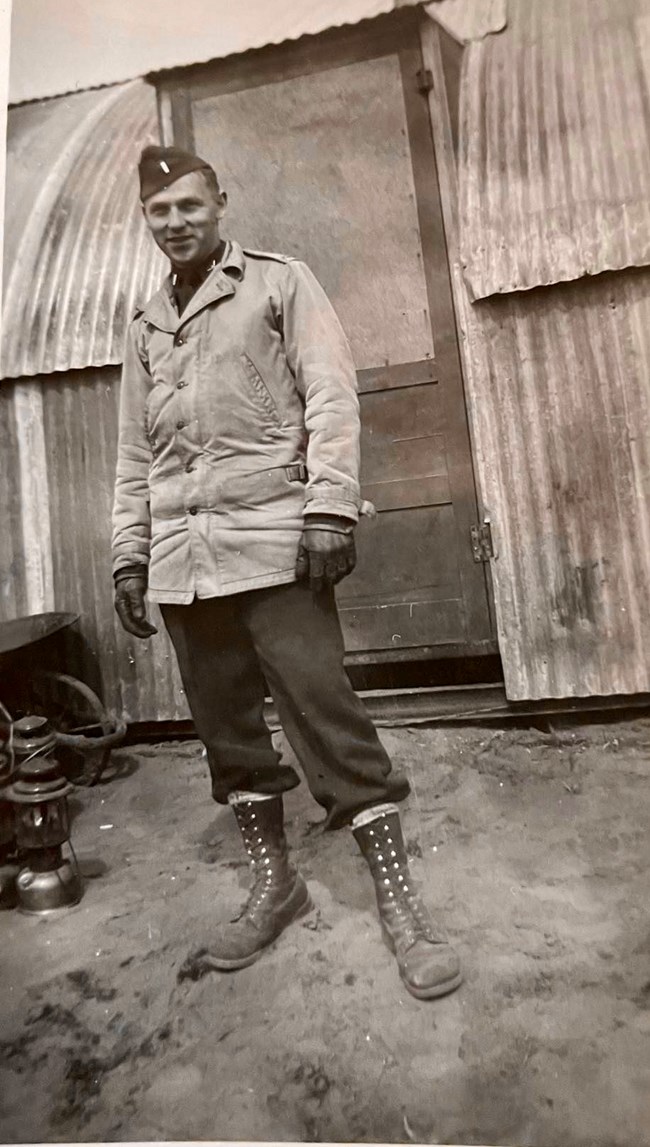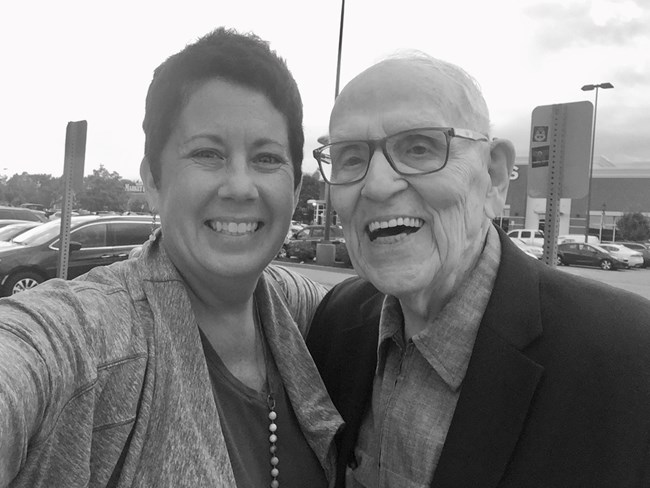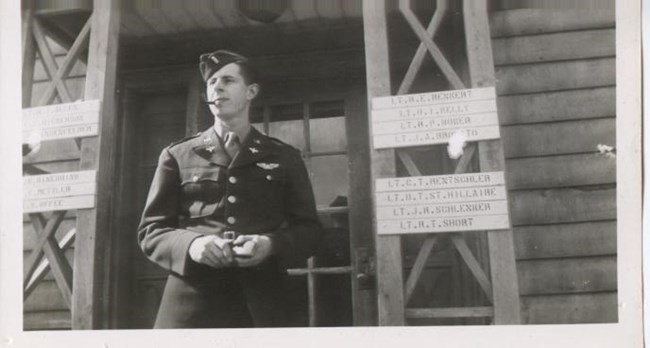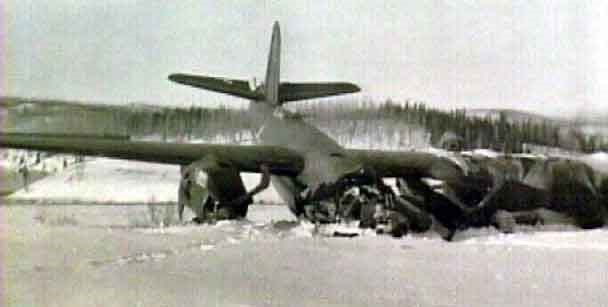Part of a series of articles titled The Williwaw Newsletter.
Previous: Williwaw January 2023
Article
This issue is packed with stories of the WWII Aleutian Campaign. One of them tells of the service of Paul Schaughency, whose daughter and son-in-law retraced his steps in the Aleutians in 2022 on a Valor Tour. Readers will also get a glimpse into the life of a pilot, Lt. Richard Short, who flew missions along the Aleutian Islands moving men and supplies with the 54th Troop Carrier Squadron. Without these pilots and planes, mission would have been delayed and replacement GIs would have had to brave the Bering Sea, although the editorial board cannot definitely say which would be the safer method of travel given the weather. Another story involves the “Million Dollar Valley” in Canada’s Yukon Territory where three B-26 bombers were forced to land in a snowstorm. The editors have also reached into the National Archive to pull out the diary of Coast Artillery (AA) to bring you the excerpts from 3 and 4 June 1942, when the Japanese attacked our military installations at Dutch Harbor.
We are pleased to announce a wonderful new publication that should make warplane afficionados very happy. As this issue of the Williwaw comes out, Aircraft of the WWII Aleutian Campaign is going to press, and should be out by the end of the calendar year. Readers should also keep their eyes open in 2024 for another publication that has been decades in the making. We are working on a collection of World War II narratives pulled from the dozens of oral history interviews volunteers and National Park Service staff have conducted over many decades. And wait, there’s more! The Aleutian WWII Calendar will be back in 2024 after a hiatus of two years.
As always, we welcome letters, stories, and photos from readers. Please contact Rachel Mason at the Aleutian WWII National Historic Area, National Park Service, at e-mail us or 907-240-4917.

Courtesy of Karen Abel
by Karen Abel
Over several summers I have had the honor of leading WWII History Expeditions through the Aleutian Islands. This unique tour was originated by the late Col. (RET) John Cloe, 11th Air Force historian in 2013 and is operated by Valor Tours, one of the oldest tour companies around. After John became ill, Allison Everett and I took over the expedition in 2017, with his blessing. It is an incredible privilege to be able to share this part of the world and its history with other people, particularly with veterans’ family members. I first became involved with the tour because of my own family connection. My grandfather Robert Lynch was a fighter pilot with 111 Fighter Squadron, RCAF, during the campaign. Since 2012, I have been on a mission to retrace his wartime footsteps. I vividly remember the first time I stepped foot on the same battered soil as my grandfather and experienced first-hand the weather, the remoteness and the vastness of such a battleground. It was as exasperating as it was awe-inspiring.
Although the islands are commonly described as barren, desolate and windswept, they also have quite a memorable allure. In the summer bright green grass reminiscent of velvet covers every nook, crevasse and curve of the subvolcanic peaks. Bountiful wildflowers and berries, spread throughout the landscape, provide pops of color as beautiful as anything you’d see on the mainland. It’s the other side to the bleak landscape of war, and it’s always a pleasure to share it with people.
Every tour so far has included at least one veteran’s family member. In 2016, I was that person, honoring my grandfather. In 2017 two daughters of veterans joined the tour. Barbara Johns’ father, Major Thomas Jackson, commanded the 54th FS and was killed over Kiska when his P-38 collided with another in a dog fight. Barbara was only three weeks old at the time. Sharon Cin’s father, Robert Smith, was a Navy storekeeper on several Aleutian bases. He had an immense photo collection from which we were able to pull a few photos for the upcoming National Park Service publication “WWII Aircraft of the Aleutians.” For the 2018 tour, Peter Amundson voyaged all the way to Attu to memorialize his father Milton Amundson’s service with the 7th Infantry Division in the gruesome Battle of Attu. And in a modified land tour in June 2022, two daughters of campaign veterans joined us to retrace their fathers’ footsteps on Adak and in Dutch Harbor: Liz Miller, whose father was on the destroyer tender USS Markab; and Kitty Crider, whose father was Captain Paul Schaughency.
Some of you may remember Kitty’s dad. He was one of roughly a dozen veterans who traveled to Alaska to commemorate the 75th Anniversary of the Bombing of Dutch Harbor & Aleut Evacuation in 2017, and the 75th Anniversary of the Battle of Attu in 2018. Paul was full of life, a fantastic storyteller and even sang barbershop well into his later years. He passed away in the summer of 2022 at the very time Kitty was retracing his Alaskan routes. Paul was the last surviving member of the beloved group of veterans who participated in commemorations of the Aleutian Campaign. We miss Paul’s enthusiasm and his infectious smile.

Photo courtesy of Paul Schaughency collection
by Karen Abel
Born in Beaver, PA in 1921, Paul was youngest of three boys. He joined the service through the ROTC program at the University of Pittsburgh in 1939. When the U.S. entered WWII in 1940, Paul and his ROTC classmates were directed to finish their schooling. Paul graduated and received his commission in 1943. After a Coast Artillery assignment, Harbor Defense of New York City at Fort Hancock, NJ, by January 1944 he found himself and his regiment on Adak, in the Aleutian Islands.
Paul became the duty officer on Adak the first night he arrived there, even though he was the junior officer for the whole group. He recalled, “They say, ‘Schaughency, you are duty officer.’ I said ‘Ok, what does that involve?’ They told me ‘Just go down there and sleep in the signal place there. They have a small crew with you there.’ ‘Ok, are there any duties?’ ‘Well… just go down there.’ So I get there and turn in. In the middle of the night, the coast artillery has radar, for defense you know, and the Sergeant wakes me up and says, ‘Lieutenant, we just heard from the radar and there is an unidentified object off of Cape Adagdak and it is heading for Cape Chigigegak [Kagigikak].’ …The only word I knew at that point was the word Adak, which was our island. I later learned that everything up there in the Aleutians was Russian derivation. I said ‘Well, where is that?’ so he gets a map out and says Cape Adagdak is out here and Cape Chigigegak, that’s another island.’ And he says [about the unidentified object], ‘It is probably a flock of geese that is unidentified. We get that quite a bit.’ I say ‘Ok.’ He says, ‘Don’t worry about it.’ I’m not worrying about it! That was my introduction to the Aleutians. You see—I still remember those two big long Russian names, the geographic names.”
While on Adak, Paul had various assignments as an officer in the mess, motor pool, and a firing battery before he worked his way up to becoming the battalion’s Personnel Officer and ultimately the Post’s Adjunct. He was stationed at even more remote outposts, Zeto Point and Shagak Bay. Typical of Paul’s joyful nature, he didn’t mind. The Army, to make up for the isolation, provided the men in the Aleutians with 25% more food than other units. The Army knew that the way to a man’s heart is through this stomach.

Photo courtesy Karen Abel
The military put a small detachment over at Shagak Bay to protect against a backdoor landing of Japanese forces. It was so removed from the main post that it required a boat ride across a bay just to get to a trail that led about a mile or so up the side of the mountain to a long windy road that took you into the main post. I’ve hiked the trail a few times and it is not as “nice and easy” as Paul remembers it. I have also lost count of the number of stream and ravine crossings needed along the way.
One of Paul’s most memorable moments took place in this valley. On a beautiful sunny day in June, a priest and three nurses from the 179th Station Hospital decided to visit the unit at Shagak Bay. The group was dropped off on the dock. Later on, the Adak unit received a phone call from Shagak Bay asking whether the priest and nurses were all right. Paul said that the group had gone up the hill from the dock and everything seemed fine. The caller said, “Well, we are up here at the end of the trail and they are not here. Could you send a search party out? It is starting to snow a little up here and we are concerned.”
Although not exactly trained in search and rescue, Paul organized a group of six men to go after the lost visitors. He told them, “Here is what we are going to do--I’ll be in the middle, three on this side, and three on this side… If the snow comes, close in, we don’t want to lose anybody else now so you just move in. And when you do see the tracks, stop, and we’ll see you not moving and still go like this with your arms and point down.” The search party followed that plan. By then it was nearly dusk and snowing even harder. Snow machines from the main base were in the valley also searching for the lost party who were not at all dressed for this type of weather. One of Paul’s men reasoned, “…that blizzard is coming down off the mountain [Mount Moffitt] and you have a tendency to put your back to the blizzard. They could have gone down and followed this ravine down here.” Another guy familiar with the area said “There is an old trapper’s shack down there. I’ll bet that is where they are!” The search party found the priest and nurses in the shack. Everybody on that team got a commendation letter from the general.
I was able to take Paul’s daughter Kitty, her husband Les, and the rest of the tour group along the side of that same mountain towards the lake. We looked for the remnants of the old trapper’s shack, but without any luck. It was likely swept away by the wind that must whip through this valley like a freight train. Without a boat, we were unable to make it all the way to the actual outpost on the other side of the lake. Regardless, we saw enough to imagine what they had to go through.
Not long after that Paul, was assigned to the Adak Post Headquarters which overlooked Kuluk Bay and the main Naval Base. In August 1945, when word arrived that the war had ended, dozens of Navy vessels spotted the harbor, positioned and ready to head to Hokkaido, Japan. Looking at the ships, Paul reflected that now none of those crews would have to face death.
It is through history that we learn our way forward. These tours provide insight into the building blocks of our ancestors: the hardships, grit and grace that made up the greatest generation. It is up to us, the next generations, to keep talking about the lessons learned in mass conflict and to keep it from happening again.
After the war ended, Paul opted to stay on Adak, taking an extra assignment as the Post Adjunct. One of the draws for him was that the position allowed for his wife Cathy to join him; they were practically newlyweds, having been married just seven days before he left for Alaska. Of course, she had no idea what she was getting into, but she managed well. They moved into a converted Quonset hut and Cathy began working in civilian personnel. By that time the base was equipped with theaters, bowling alleys, stores, and recreation centers--many of the comforts of home with some additional wind!

Photo courtesy of Richard T. Short II (son), from the collection of 1st Lt. Richard T. Short

by Karen Abel
Watson Lake, Yukon Territory was a stop along the WWII-era Northwest Staging Route for military planes on their way to Alaska. Less than a hundred miles away sits a flat valley monikered the Million Dollar Valley in the 1940s. The name came not from the value of the land, but from the value of the three abandoned B-26 Marauders that lay at the bottom of the valley, and the expense of recovering the aircraft.
Very early in the war, in January 1942, a group of newly graduated pilots and crew from the 77th Bombardment Squadron were assigned the task of bringing 14 B-26s up to Alaska from Sacramento, California. The 2300-mile inside route through Canada’s virtually unmapped wilderness would take them first to Portland and Spokane, then north to Edmonton. From that point on, pilots had no navigational aids and traveled through virtually unmapped areas. Some of them used hand drawn maps penciled on napkins they obtained from Canadian bush pilots to guide the next thousand miles from Edmonton to Whitehorse. At one point, while passing through Fort Nelson, British Columbia, three B-26s encountered a snowstorm, forcing them to descend below the clouds. The pilots managed to keep each other in sight and steer clear of the mountains but subsequently got lost in the process. Low on fuel and low on light, they decided their best option was to land in a snow-covered valley. The first two bombers landed on their bellies, skidding to rest. The third pilot extended his landing gear in an attempt to slow the B-26 down enough for landing. The snow in the valley appeared shallow and compact, but was not, as he quickly found out. The B-26 sank into the snow, then snagged itself on the shrubs that lay beneath the sparkly white powder. Ultimately the nose gear collapsed and the force threw pilot 2nd Lt. William Dancer from the cockpit while co-pilot 2nd Lt. Howard Smiley, with just 10 hours behind the stick, was knocked unconscious and trapped in his seat, his legs stuck under the rudder pedals.
Fortunately, they were the only ones injured in the ordeal. The other crews rushed to set up shelters using the wing covers and care for the two injured pilots. They attempted to make contact with the base, to no avail. Between them the crews had enough arctic gear and food supplies to last a few weeks. It now became a waiting game.
Meanwhile, then Lt. Jack Chennault left the Sacramento Air Depot with 24 P-40s from the 11th Fighter Squadron, trailing the bombers on their route. When Chennault’s planes got to Canada they were sent to search for the lost B-26s from the 77th Bombardment Squadron. He recalled that he “stretched 11 planes as far apart as possible so they could see my plane.” The downed B-26 crews, hearing the aircraft, shot off every flare and bit of ammunition they had in hopes of gaining the formations attention. It worked! Chennault spotted the bombers, radioed their location to the base and circled for some time before leaving. The next day, Canadian bush-pilot Russ Baker landed his Focker on skis near the aircraft and evacuated the injured. The rest of the crews were picked up in the following days.
As for the aircraft, the U.S. Army Air Force realized the difficulty of making a full recovery of the planes in such a remote area. Instead, they sent a crew of mechanics to the crash site to strip the new Marauders of all useable parts, including the engines, armament, radios, instruments, and landing gear.
The planes remained in place until 1971, when a group of warbird enthusiasts set off for Fort Nelson, British Columbia to find the three 30-year-old bombers sitting, as if time had stood still, in their exact landing spots. The group spent many days carefully dissembling the abandoned bombers and staging them for a rail trip to Southern California where they would eventually be used, and two of them rebuilt.
You can find one of the two rebuilt Million Dollar Valley B-26s in Canton, Ohio at the Military Aviation Preservation Society Museum. The B-26 in Ohio is a combination of two of the B-26s; they took the nose from one and grafted it to the body of another. The aircraft sits complete as a static display. The other potentially airworthy B-26 can be seen at Kermit Weeks Fantasy of Flight in Lakeland, Florida. It too, was rebuilt using parts from two of the aircraft that landed in the Million Dollar Valley.
by Joshua Bell
Sec. #2 up at 4, others at 6:45 A. Just after breakfast at 7:00 A, first report of Jap[anese] attack on Dutch Harbor. Rumors of size of attacking force, and of damage done, fly all day. Men on double alert all morning, on single alert, with one man on each gun, rest of day till dark. Jap[anese] plane sneaked in behind ship rock in morning, cut down in 5 secs by Lt. Murphy in P-40. Dinner in groups at 12:30P. Water detail carried on. Supper at 5:30 P. Men to sleep fully clothed ready to fall out anytime during night. Will be called at daybreak, bet 3:30-4:00 A. Two alerts before midnight - a PBY and B-17 (Flying Fortress.)
That day, five soldiers of the 206th C.A. were killed in action: Private Claude H. Biggs, Battery F, Private Allen C. Collier, Jr., HQ Battery, 2nd Battalion, Private James E. Harrington, Battery E, Private Hugh Bryan Timberlake, Battery B, Private James R. Wiles, Battery C.
All men up at 5:00 A breakfast at 5:30 A. Men ready to man guns at instant’s notice; kept two men on each gun all day. Around 5:00 P came word Dutch Harbor attacked again. Half hour later 3 Jap[anese] planes, flying southwest, nearly over Pusto Island seen. Double alert sounded. Our planes engaged enemy at so close a range (dog fighting) that guns unable to be fired. Besides, all but perhaps one enemy plane, past our range at all times. First attack driven off around 6:30 P. Men ate supper in shifts. Second and shorter attack around 8:00 P. Double alert continued until 9:00 P. Single alert with two men on each gun till 10:00 P. Single alert with double guard 10:00 P till 5:00 A. Night uneventful.
On the second day of the attacks, the Japanese had claimed the lives of Privates Charles W. Hill and Ambrose D. Regalia, both of Battery F.
Part of a series of articles titled The Williwaw Newsletter.
Previous: Williwaw January 2023
Last updated: July 18, 2025